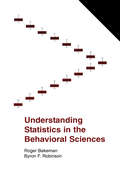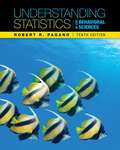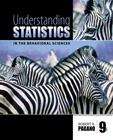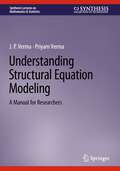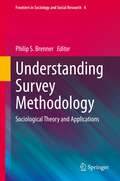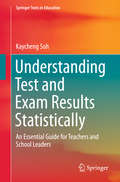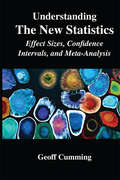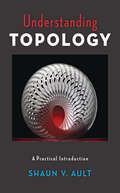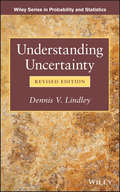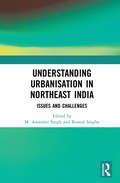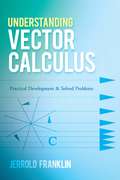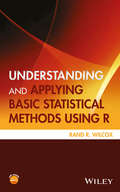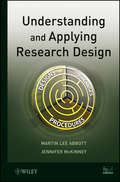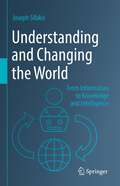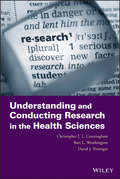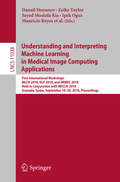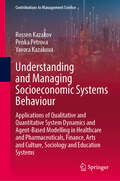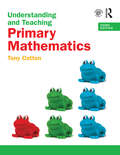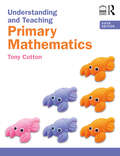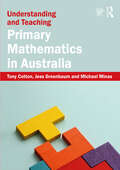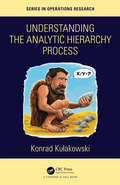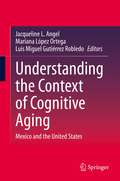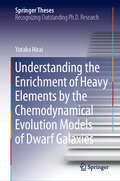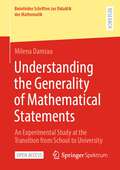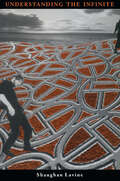- Table View
- List View
Understanding Statistics in the Behavioral Sciences
by Roger Bakeman Byron F. RobinsonUnderstanding Statistics in the Behavioral Sciences is designed to help readers understand research reports, analyze data, and familiarize themselves with the conceptual underpinnings of statistical analyses used in behavioral science literature. The authors review statistics in a way that is intended to reduce anxiety for students who feel intimidated by statistics. Conceptual underpinnings and practical applications are stressed, whereas algebraic derivations and complex formulas are reduced. New ideas are presented in the context of a few recurring examples, which allows readers to focus more on the new statistical concepts than on the details of different studies.The authors' selection and organization of topics is slightly different from the ordinary introductory textbook. It is motivated by the needs of a behavioral science student, or someone in clinical practice, rather than by formal, mathematical properties. The book begins with hypothesis testing and then considers how hypothesis testing is used in conjunction with statistical designs and tests to answer research questions. In addition, this book treats analysis of variance as another application of multiple regression. With this integrated, unified approach, students simultaneously learn about multiple regression and how to analyze data associated with basic analysis of variance and covariance designs. Students confront fewer topics but those they do encounter possess considerable more power, generality, and practical importance. This integrated approach helps to simplify topics that often cause confusion.Understanding Statistics in the Behavioral Sciences features:*Computer-based exercises, many of which rely on spreadsheets, help the reader perform statistical analyses and compare and verify the results using either SPSS or SAS. These exercises also provide an opportunity to explore definitional formulas by altering raw data or terms within a formula and immediately see the consequences thus providing a deeper understanding of the basic concepts.*Key terms and symbols are boxed when first introduced and repeated in a glossary to make them easier to find at review time.*Numerous tables and graphs, including spreadsheet printouts and figures, help students visualize the most critical concepts.This book is intended as a text for introductory behavioral science statistics. It will appeal to instructors who want a relatively brief text. The book's active approach to learning, works well both in the classroom and for individual self-study.
Understanding Statistics in the Behavioral Sciences (Tenth Edition)
by Robert R. Pagano<p>Based on over 30 years of successful teaching experience in this course, Robert Pagano's introductory text takes an intuitive, concepts-based approach to descriptive and inferential statistics. He uses the sign test to introduce inferential statistics, empirically derived sampling distributions, many visual aids, and lots of interesting examples to promote reader understanding. <p>One of the hallmarks of this text is the positive feedback from users--even those not mathematically inclined praise the text for its clarity, detailed presentation, and use of humor to help make concepts accessible and memorable. Thorough explanations precede the introduction of every formula, and the exercises that immediately follow include a step-by-step model that lets readers compare their work against fully solved examples. This combination makes the text perfect for anyone building their foundation of knowledge for analyzing statistics in psychology or other social and behavioral sciences.</p>
Understanding Statistics in the Behavioural Sciences (9th edition)
by Robert R. PaganoBased on over 30 years of successful teaching experience in this course, Robert Pagano's introductory text takes an intuitive, concepts-based approach to descriptive and inferential statistics. He uses the sign test to introduce inferential statistics, empirically derived sampling distributions, many visual aids and lots of interesting examples to promote student understanding. One of the hallmarks of this text is the positive feedback from students-even students who are not mathematically inclined praise the text for its clarity, detailed presentation, and use of humor to help make concepts accessible and memorable. Thorough explanations precede the introduction of every formula-and the exercises that immediately follow include a step-by-step model that lets students compare their work against fully solved examples. This combination makes the text perfect for students taking their first statistics course in psychology or other social and behavioral sciences.
Understanding Structural Equation Modeling: A Manual for Researchers (Synthesis Lectures on Mathematics & Statistics)
by J.P. Verma Priyam VermaThis book presents a comprehensive overview of Structural Equation Modeling and how it can be applied to address research issues in different disciplines. The authors employ a ‘simple to complex’ approach. The book reviews topics such as variance, covariance, correlation, multiple regression, mediation, moderation, path analysis, and confirmatory factor analysis. The authors then discuss the initial steps for performing structural equation modeling, including model specification, model identification, model estimation, model testing, and model modification. The book includes an introduction to the IBM SPSS and IBM SPSS Amos software. The authors the explain how this software can be utilized for developing measurement, structural models, and SEM models. The book provides conceptual clarity in understanding the models and discusses practical approaches to solving them. The authors also highlight how these techniques can be applied to various disciplines, including psychology, education, sociology, business, medicine, political science, and biological sciences.
Understanding Survey Methodology: Sociological Theory and Applications (Frontiers in Sociology and Social Research #4)
by Philip S. BrennerThis volume ambitiously applies sociological theory to create an understanding of aspects of survey methodology. It focuses on the interplay between sociology and survey methodology: what sociological theory and approaches can offer to survey research and vice versa. The volume starts with a focus on direct connections between sociological theories and their applications in survey research. It further presents cutting-edge, original research that applies the “sociological imagination” to substantive concerns important to sociologists, survey methodologists, and social scientists and includes issues such as health, immigration, race/ethnicity, gender and sexuality, and criminal justice.
Understanding Test and Exam Results Statistically
by Kaycheng SohThis book shares the goal of the classic text How to Lie with Statistics, namely, preventing and correcting statistical misconceptions that are common among practitioners, though its focus is on the educational context. It illustrates and discusses the essentials of educational statistics that will help educational practitioners to do this part of their job properly, i. e. , without making conceptual mistakes. The examples are cast in the school/classroom contexts, based on realistic rather than theoretical examples.
Understanding The New Statistics: Effect Sizes, Confidence Intervals, and Meta-Analysis (Multivariate Applications Series)
by Geoff CummingThis is the first introductory statistics text to use an estimation approach from the start to help readers understand effect sizes, confidence intervals (CIs), and meta-analysis ('the new statistics'). It is also the first text to explain the new and exciting Open Science practices, which encourage replication and enhance the trustworthiness of research. In addition, the book explains NHST fully so students can understand published research. Numerous real research examples are used throughout. The book uses today's most effective learning strategies and promotes critical thinking, comprehension, and retention, to deepen users' understanding of statistics and modern research methods. The free ESCI (Exploratory Software for Confidence Intervals) software makes concepts visually vivid, and provides calculation and graphing facilities. The book can be used with or without ESCI. Other highlights include: - Coverage of both estimation and NHST approaches, and how to easily translate between the two. - Some exercises use ESCI to analyze data and create graphs including CIs, for best understanding of estimation methods. -Videos of the authors describing key concepts and demonstrating use of ESCI provide an engaging learning tool for traditional or flipped classrooms. -In-chapter exercises and quizzes with related commentary allow students to learn by doing, and to monitor their progress. -End-of-chapter exercises and commentary, many using real data, give practice for using the new statistics to analyze data, as well as for applying research judgment in realistic contexts. -Don't fool yourselftips help students avoid common errors. -Red Flagshighlight the meaning of "significance" and what pvalues actually mean. -Chapter outlines, defined key terms, sidebars of key points, and summarized take-home messages provide a study tool at exam time. -http://www. routledge. com/cw/cumming offers for students: ESCI downloads; data sets; key term flashcards; tips for using SPSS for analyzing data; and videos. For instructors it offers: tips for teaching the new statistics and Open Science; additional homework exercises; assessment items; answer keys for homework and assessment items; and downloadable text images; and PowerPoint lecture slides. Intended for introduction to statistics, data analysis, or quantitative methods courses in psychology, education, and other social and health sciences, researchers interested in understanding the new statisticswill also appreciate this book. No familiarity with introductory statistics is assumed.
Understanding Topology: A Practical Introduction
by Shaun V. AultA fresh approach to topology makes this complex topic easier for students to master.Topology—the branch of mathematics that studies the properties of spaces that remain unaffected by stretching and other distortions—can present significant challenges for undergraduate students of mathematics and the sciences. Understanding Topology aims to change that.The perfect introductory topology textbook, Understanding Topology requires only a knowledge of calculus and a general familiarity with set theory and logic. Equally approachable and rigorous, the book's clear organization, worked examples, and concise writing style support a thorough understanding of basic topological principles. Professor Shaun V. Ault's unique emphasis on fascinating applications, from mapping DNA to determining the shape of the universe, will engage students in a way traditional topology textbooks do not.This groundbreaking new text:• presents Euclidean, abstract, and basic algebraic topology• explains metric topology, vector spaces and dynamics, point-set topology, surfaces, knot theory, graphs and map coloring, the fundamental group, and homology• includes worked example problems, solutions, and optional advanced sections for independent projectsFollowing a path that will work with any standard syllabus, the book is arranged to help students reach that "Aha!" moment, encouraging readers to use their intuition through local-to-global analysis and emphasizing topological invariants to lay the groundwork for algebraic topology.
Understanding Uncertainty (Wiley Series in Probability and Statistics)
by Dennis V. LindleyPraise for the First Edition"...a reference for everyone who is interested in knowing and handling uncertainty."--Journal of Applied StatisticsThe critically acclaimed First Edition of Understanding Uncertainty provided a study of uncertainty addressed to scholars in all fields, showing that uncertainty could be measured by probability, and that probability obeyed three basic rules that enabled uncertainty to be handled sensibly in everyday life. These ideas were extended to embrace the scientific method and to show how decisions, containing an uncertain element, could be rationally made.Featuring new material, the Revised Edition remains the go-to guide for uncertainty and decision making, providing further applications at an accessible level including:A critical study of transitivity, a basic concept in probabilityA discussion of how the failure of the financial sector to use the proper approach to uncertainty may have contributed to the recent recessionA consideration of betting, showing that a bookmaker's odds are not expressions of probabilityApplications of the book's thesis to statisticsA demonstration that some techniques currently popular in statistics, like significance tests, may be unsound, even seriously misleading, because they violate the rules of probabilityUnderstanding Uncertainty, Revised Edition is ideal for students studying probability or statistics and for anyone interested in one of the most fascinating and vibrant fields of study in contemporary science and mathematics.
Understanding Urbanisation in Northeast India: Issues and Challenges
by Komol Singha M. Amarjeet SinghThis volume explores the dynamics of urbanisation in Northeast India. It discusses the impact of the process of urbanisation on the environment, infrastructure and socio-economic conditions of the region. The chapters in the book: Examine various challenges and opportunities of urbanisation, such as frontier urbanism, urban congestion, smart cities, vernacular architecture, urban water and waste management, cross-border migration and ethnicity. Draw attention to critical issues that have massively disturbed the urban landscape including deterioration of water quality, seismic activity and air pollution. Give alternatives that could present possible solutions to the problems afflicting this region. Drawing on case studies rooted in extensive fieldwork, this book will be indispensable to researchers and students of urban studies, human geography, development economics, cultural studies and South Asian studies. It will also be of interest to policy-makers, government representatives and town planners.
Understanding Vector Calculus: Practical Development and Solved Problems (Dover Books on Mathematics)
by Jerrold FranklinThis concise text was created as a workbook for learning to use vector calculus in practical calculations and derivations. Its only prerequisite is a familiarity with one-dimensional differential and integral calculus. Though it often makes use of physical examples, knowledge of physics itself is not required to study the mathematics of vector calculus. The approach is suitable for advanced undergraduates and graduate students in mathematics, physics, and other areas of science. The two-part treatment opens with a brief text that develops vector calculus from the very beginning and then addresses some more detailed applications. Topics include vector differential operators, vector identities, integral theorems, Dirac delta function, Green's functions, general coordinate systems, and dyadics. The second part consists of answered problems, all closely related to the development of vector calculus in the text. Those who study this book and work out the problems will find that rather than memorizing long equations or consulting references, they will be able to work out calculations as they go. Dover original publication.
Understanding and Applying Basic Statistical Methods Using R
by Rand R. WilcoxFeatures a straightforward and concise resource for introductory statistical concepts, methods, and techniques using R Understanding and Applying Basic Statistical Methods Using R uniquely bridges the gap between advances in the statistical literature and methods routinely used by non-statisticians. Providing a conceptual basis for understanding the relative merits and applications of these methods, the book features modern insights and advances relevant to basic techniques in terms of dealing with non-normality, outliers, heteroscedasticity (unequal variances), and curvature. Featuring a guide to R, the book uses R programming to explore introductory statistical concepts and standard methods for dealing with known problems associated with classic techniques. Thoroughly class-room tested, the book includes sections that focus on either R programming or computational details to help the reader become acquainted with basic concepts and principles essential in terms of understanding and applying the many methods currently available. Covering relevant material from a wide range of disciplines, Understanding and Applying Basic Statistical Methods Using R also includes: Numerous illustrations and exercises that use data to demonstrate the practical importance of multiple perspectives Discussions on common mistakes such as eliminating outliers and applying standard methods based on means using the remaining data Detailed coverage on R programming with descriptions on how to apply both classic and more modern methods using R A companion website with the data and solutions to all of the exercises Understanding and Applying Basic Statistical Methods Using R is an ideal textbook for an undergraduate and graduate-level statistics courses in the science and/or social science departments. The book can also serve as a reference for professional statisticians and other practitioners looking to better understand modern statistical methods as well as R programming.
Understanding and Applying Research Design
by Martin Lee Abbott Jennifer MckinneyA fresh approach to bridging research design with statistical analysis While good social science requires both research design and statistical analysis, most books treat these two areas separately. Understanding and Applying Research Design introduces an accessible approach to integrating design and statistics, focusing on the processes of posing, testing, and interpreting research questions in the social sciences.The authors analyze real-world data using SPSS software, guiding readers on the overall process of science, focusing on premises, procedures, and designs of social scientific research. Three clearly organized sections move seamlessly from theoretical topics to statistical techniques at the heart of research procedures, and finally, to practical application of research design:Premises of Research introduces the research process and the capabilities of SPSS, with coverage of ethics, Empirical Generalization, and Chi Square and Contingency Table AnalysisProcedures of Research explores key quantitative methods in research design including measurement, correlation, regression, and causationDesigns of Research outlines various design frameworks, with discussion of survey research, aggregate research, and experimentsThroughout the book, SPSS software is used to showcase the discussed techniques, and detailed appendices provide guidance on key statistical procedures and tips for data management. Numerous exercises allow readers to test their comprehension of the presented material, and a related website features additional data sets and SPSS code.Understanding and Applying Research Design is an excellent book for social sciences and education courses on research methods at the upper-undergraduate level. The book is also an insightful reference for professionals who would like to learn how to pose, test, and interpret research questions with confidence.
Understanding and Changing the World: From Information to Knowledge and Intelligence
by Joseph SifakisThis book discusses the importance of knowledge as an intangible asset, separate from physical entities, that can enable us to understand and/or change the world. It provides a thorough treatment of knowledge, one that is free of ideological and philosophical preconceptions, and which relies exclusively on concepts and principles from the theory of computing and logic. It starts with an introduction to knowledge as truthful and useful information, and its development and management by computers and humans. It analyses the relationship between computational processes and physical phenomena, as well as the processes of knowledge production and application by humans and computers. In turn, the book presents autonomous systems that are called upon to replace humans in complex operations as a step toward strong AI, and discusses the risks – real or hypothetical – of the careless use of these systems. It compares human and machine intelligence, attempting to answer the question of whether and to what extent computers, as they stand today, can approach human-level situation awareness and decision-making. Lastly, the book explains the functioning of individual consciousness as an autonomous system that manages short- and long-term objectives on the basis of value criteria and accumulated knowledge. It discusses how individual values are shaped in society and the role of institutions in fostering and maintaining a common set of values for strengthening social cohesion. The book differs from books on the philosophy of science in many respects, e.g. by considering knowledge in its multiple facets and degrees of validity and truthfulness. It follows the dualist tradition of logicians, emphasizing the importance of logic and language and considering an abstract concept of information very different from the one used in the physical sciences. From this perspective, it levels some hopefully well-founded criticism at approaches that consider information and knowledge as nothing more than the emergent properties of physical phenomena. The book strikes a balance between popular books that sidestep fundamental issues and focus on sensationalism, and scientific or philosophical books that are not accessible to non-experts. As such, it is intended for a broad audience interested in the role of knowledge as a driver for change and development, and as a common good whose production and application could shape the future of humanity.
Understanding and Conducting Research in the Health Sciences
by Christopher J. Cunningham Bart L. Weathington David J. PittengerA comprehensive introduction to behavioral and social science research methods in the health sciencesUnderstanding and Conducting Research in the Health Sciences is designed to develop and facilitate the ability to conduct research and understand the practical value of designing, conducting, interpreting, and reporting behavioral and social science research findings in the health science and medical fields. The book provides complete coverage of the process behind these research methods, including information-gathering, decision formation, and results presentation.Examining the application of behavioral and social science research methodologies within the health sciences, the book focuses on implementing and developing relevant research questions, collecting and managing data, and communicating various research perspectives. An essential book for readers looking to possess an understanding of all aspects of conducting research in the health science field, Understanding and Conducting Research in the Health Sciences features:Various research designs that are appropriate for use in the health sciences, including single-participant, multi-group, longitudinal, correlational, and experimental designsStep-by-step coverage of single-factor and multifactor studies as well as single-subject and nonexperimental methodsAccessible chapter explanations, real-world examples, and numerous illustrations throughoutGuidance regarding how to write about research within the formatting styles of the American Medical Association and the American Psychological AssociationThe book is an excellent educational resource for healthcare and health service practitioners and researchers who are interested in conducting and understanding behavioral and social science research done within the health sciences arena. The book is also a useful resource for students taking courses in the fields of medicine, public health, epidemiology, biostatistics, and the health sciences.
Understanding and Interpreting Machine Learning in Medical Image Computing Applications: First International Workshops, Mlcn 2018, Dlf 2018, And Imimic 2018, Held In Conjunction With Miccai 2018, Granada, Spain, September 16-20, 2018, Proceedings (Lecture Notes in Computer Science #11038)
by Sergio Pereira Mauricio Reyes M. Jorge Cardoso Ipek Oguz Lena Maier-Hein Danail Stoyanov Zeike Taylor Anne Martel Seyed Mostafa Kia Andre F. Marquand Edouard Duchesnay Tommy Löfstedt Bennett Landman Carlos A. Silva Raphael MeierThis book constitutes the refereed joint proceedings of the First International Workshop on Machine Learning in Clinical Neuroimaging, MLCN 2018, the First International Workshop on Deep Learning Fails, DLF 2018, and the First International Workshop on Interpretability of Machine Intelligence in Medical Image Computing, iMIMIC 2018, held in conjunction with the 21st International Conference on Medical Imaging and Computer-Assisted Intervention, MICCAI 2018, in Granada, Spain, in September 2018. The 4 full MLCN papers, the 6 full DLF papers, and the 6 full iMIMIC papers included in this volume were carefully reviewed and selected. The MLCN contributions develop state-of-the-art machine learning methods such as spatio-temporal Gaussian process analysis, stochastic variational inference, and deep learning for applications in Alzheimer's disease diagnosis and multi-site neuroimaging data analysis; the DLF papers evaluate the strengths and weaknesses of DL and identify the main challenges in the current state of the art and future directions; the iMIMIC papers cover a large range of topics in the field of interpretability of machine learning in the context of medical image analysis.
Understanding and Managing Socioeconomic Systems Behaviour: Applications of Qualitative and Quantitative System Dynamics and Agent-Based Modelling in Healthcare and Pharmaceuticals, Finance, Arts and Culture, Sociology and Education Systems (Contributions to Management Science)
by Rossen Kazakov Penka Petrova Yavora KazakovaThis book illustrates effective decision-making in complex socio-economic systems utilising system dynamics and agent-based simulation modelling approaches. It provides practical guidance on the application of conceptual and numerical modelling and simulation for analysing economic, strategic, regulatory, sociological and ethical questions from a complex systems perspective. Its theoretical, methodological and practical illustrations will enhance readers’ understanding of the application of simulation modelling for effective systems management. By virtually experimenting with alternative management scenarios, it will help them improve decision-making and control mechanisms. The book explores practical examples from the fields of pharmaceuticals, healthcare, finance, sociology, education and culture from a strategic, regulatory and ethics perspective. As such, it offers a valuable resource for managers, both at for-profit corporations and non-profit organisations, public policymakers and regulators alike.
Understanding and Teaching Primary Mathematics
by Tony CottonWritten by an education consultant with widespread experience of teaching mathematics in the UK and internationally, Understanding and Teaching Primary Mathematics seamlessly combines pedagogy and subject knowledge to build confidence and equip you with all the skills and know-how you need to successfully teach mathematics to children of any age. This 3rd edition has been fully updated to reflect the latest research developments and initiatives in the field, as well as key changes to both the UK National Curriculum and International Baccalaureate, including a brand new chapter on 'Algebra' and a reworked focus on the early years. Extra features also include helpful call-outs to the book's revised and updated companion website, which offers a shared site with a range of resources relevant to both this book and its new companion volume, Teaching for Mathematical Understanding. Stimulating, accessible and well-illustrated, with comprehensive coverage of subject knowledge and pedagogy, Understanding and Teaching Primary Mathematics is an essential purchase for trainee and practising teachers alike. Companion website features new to this edition include: video clips in which the author demonstrates the concepts covered in the book through teaching to a real class PowerPoint presentations which provide support for those using the book as a part of a teacher training course updated weblinks to external sites with useful teaching information and resources
Understanding and Teaching Primary Mathematics
by Tony CottonWritten by an experienced teacher and teacher educator with widespread experience of teaching mathematics in the UK and internationally, the bestselling Understanding and Teaching Primary Mathematics combines pedagogy and subject knowledge to build confidence and equip you with all the skills and know-how you need to successfully teach mathematics to children of any age.This fifth edition has been completely updated to include the latest developments in learning and teaching mathematics, including mastery approaches, a Singapore approach and the use of manipulatives in the primary classroom. There are new activities for you to use in your teaching and links to the dedicated website, which contains materials to develop a personal portfolio, more activities to use in your classroom and presentations and podcasts to support your further professional development to reflect the latest research developments. It covers all areas of the mathematics curriculum and will allow you to become a confident teacher of mathematics through developing your own subject knowledge.Tony draws on his many years of experience teaching mathematics and working with early career teachers to share classroom activities which will support you in learning mathematics through engaging in mathematical activity with your learners.
Understanding and Teaching Primary Mathematics in Australia
by Tony Cotton Jess Greenbaum Michael MinasWritten by experienced teacher educator and author, Tony Cotton, and two Australian primary teachers, Jess Greenbaum and Michael Minas, Understanding and Teaching Primary Mathematics in Australia combines pedagogy and mathematics subject knowledge to build teachers’ confidence both in their mathematical subject knowledge and in their ability to teach mathematics effectively. The book covers all the key areas of the Australian Curriculum for mathematics from teaching number and calculation strategies to exploring geometry and statistics. There are also chapters that deal with the teaching of mathematics in the Early Years, inclusive approaches to mathematics teaching and teaching mathematics using ICT. Stimulating, accessible and containing a wealth of practical ideas for use in the classroom, Understanding and Teaching Primary Mathematics in Australia is an essential text for graduate and practicing teachers alike.
Understanding the Analytic Hierarchy Process (Chapman & Hall/CRC Series in Operations Research)
by Konrad KulakowskiThe aim of this book is to provide the reader with a critical guide to AHP. In this book, the AHP method is considered primarily as a mathematical technique supporting the decision-making process. This method provides a convenient and versatile framework for modelling multi-criteria decision problems, evaluating alternatives and deriving final priorities. Rather than imposing a correct decision, AHP allows the user to create a ranking of alternatives, then choose the one which is the best (or among the best). At the core of AHP is a pairwise comparisons (PC) method. This is an old technique known in various forms since at least the Middle Ages.
Understanding the Context of Cognitive Aging: Mexico and the United States
by Jacqueline L. Angel Luis Miguel Gutiérrez Robledo Mariana López OrtegaThis book provides a bi-national portrait of dementia in the rapidly aging Mexican-origin population in Mexico and the United States. It provides a comprehensive overview of critical conceptual and methodological issues in the study of cognitive aging and related mental and physical conditions. The book examines the sources of vulnerability and their consequences for Mexican-origin and for “aging in place”. By providing a combination of new knowledge, empirical evidence, and fresh approaches of dementia support in later life, this book will contribute to moving the field of Mexican-origin aging and health forward. By focusing on the serious challenges in old-age support for older people with dementia and neurocognitive disorders in two different contexts, this book will deepen academics, researchers, students and young investigators understanding of what is necessary to achieve optional care.
Understanding the Enrichment of Heavy Elements by the Chemodynamical Evolution Models of Dwarf Galaxies (Springer Theses)
by Yutaka HiraiThis book addresses the mechanism of enrichment of heavy elements in galaxies, a long standing problem in astronomy. It mainly focuses on explaining the origin of heavy elements by performing state-of-the-art, high-resolution hydrodynamic simulations of dwarf galaxies. In this book, the author successfully develops a model of galactic chemodynamical evolution by means of which the neutron star mergers can be used to explain the observed abundance pattern of the heavy elements synthesized by the rapid neutron capture process, such as europium, gold, and uranium in the Local Group dwarf galaxies. The book argues that heavy elements are significant indicators of the evolutionary history of the early galaxies, and presents theoretical findings that open new avenues to understanding the formation and evolution of galaxies based on the abundance of heavy elements in metal-poor stars.
Understanding the Generality of Mathematical Statements: An Experimental Study at the Transition from School to University (Bielefelder Schriften zur Didaktik der Mathematik #15)
by Milena DamrauIn this open access book Milena Damrau investigates the understanding of generality of mathematical statements in first-year university students and its relation to other proof-related activities. Through an experimental study, she particularly analyses the effect of different types of arguments (empirical, generic, and ordinary proofs) and statements (familiar and unfamiliar, as well as true and false ones) on several proof-related activities. The results reveal students' struggles with the concept of generality, how their understanding of generality is related to proof reading and construction and how different types of arguments and statements impact students’ performance in other proof-related activities. The findings offer valuable insights for improving mathematics courses at the transition from school to university and highlight the need for more experimental studies in mathematics education.
Understanding the Infinite
by Shaughan LavineAn accessible history and philosophical commentary on our notion of infinity.How can the infinite, a subject so remote from our finite experience, be an everyday tool for the working mathematician? Blending history, philosophy, mathematics, and logic, Shaughan Lavine answers this question with exceptional clarity. Making use of the mathematical work of Jan Mycielski, he demonstrates that knowledge of the infinite is possible, even according to strict standards that require some intuitive basis for knowledge.Praise for Understanding the Infinite“Understanding the Infinite is a remarkable blend of mathematics, modern history, philosophy, and logic, laced with refreshing doses of common sense. It is a potted history of, and a philosophical commentary on, the modern notion of infinity as formalized in axiomatic set theory . . . An amazingly readable [book] given the difficult subject matter. Most of all, it is an eminently sensible book. Anyone who wants to explore the deep issues surrounding the concept of infinity . . . will get a great deal of pleasure from it.” —Ian Stewart, New Scientist“How, in a finite world, does one obtain any knowledge about the infinite? Lavine argues that intuitions about the infinite derive from facts about the finite mathematics of indefinitely large size . . . The issues are delicate, but the writing is crisp and exciting, the arguments original. This book should interest readers whether philosophically, historically, or mathematically inclined, and large parts are within the grasp of the general reader. Highly recommended.” —D. V. Feldman, Choice
